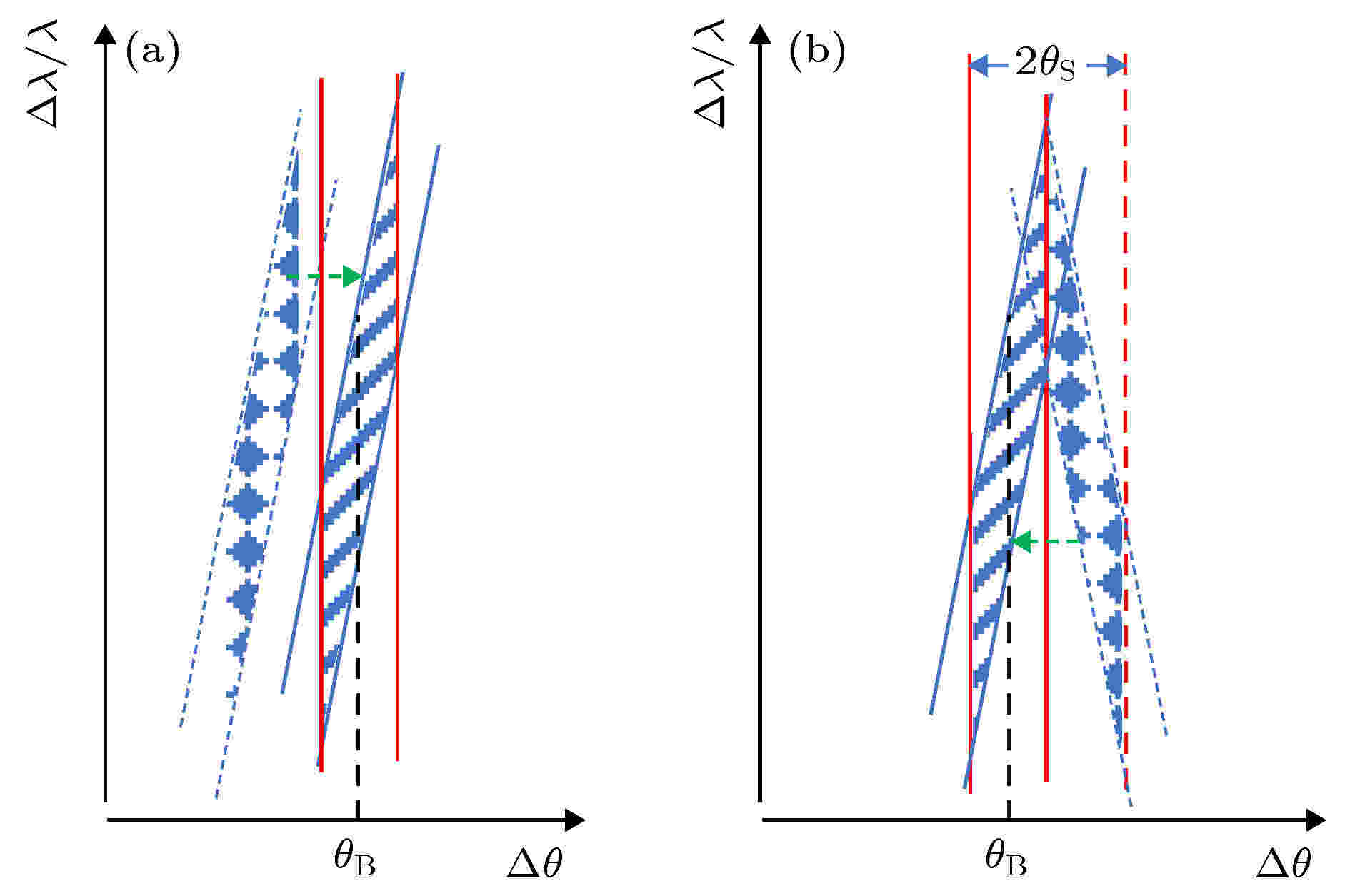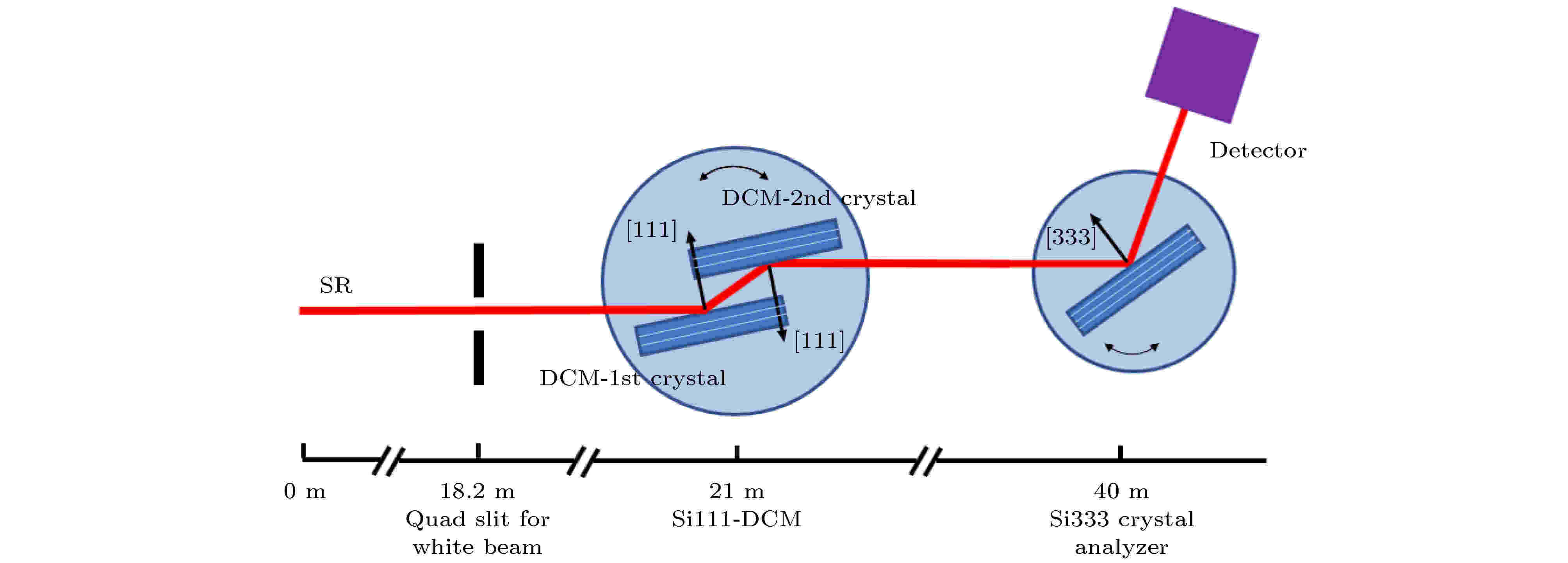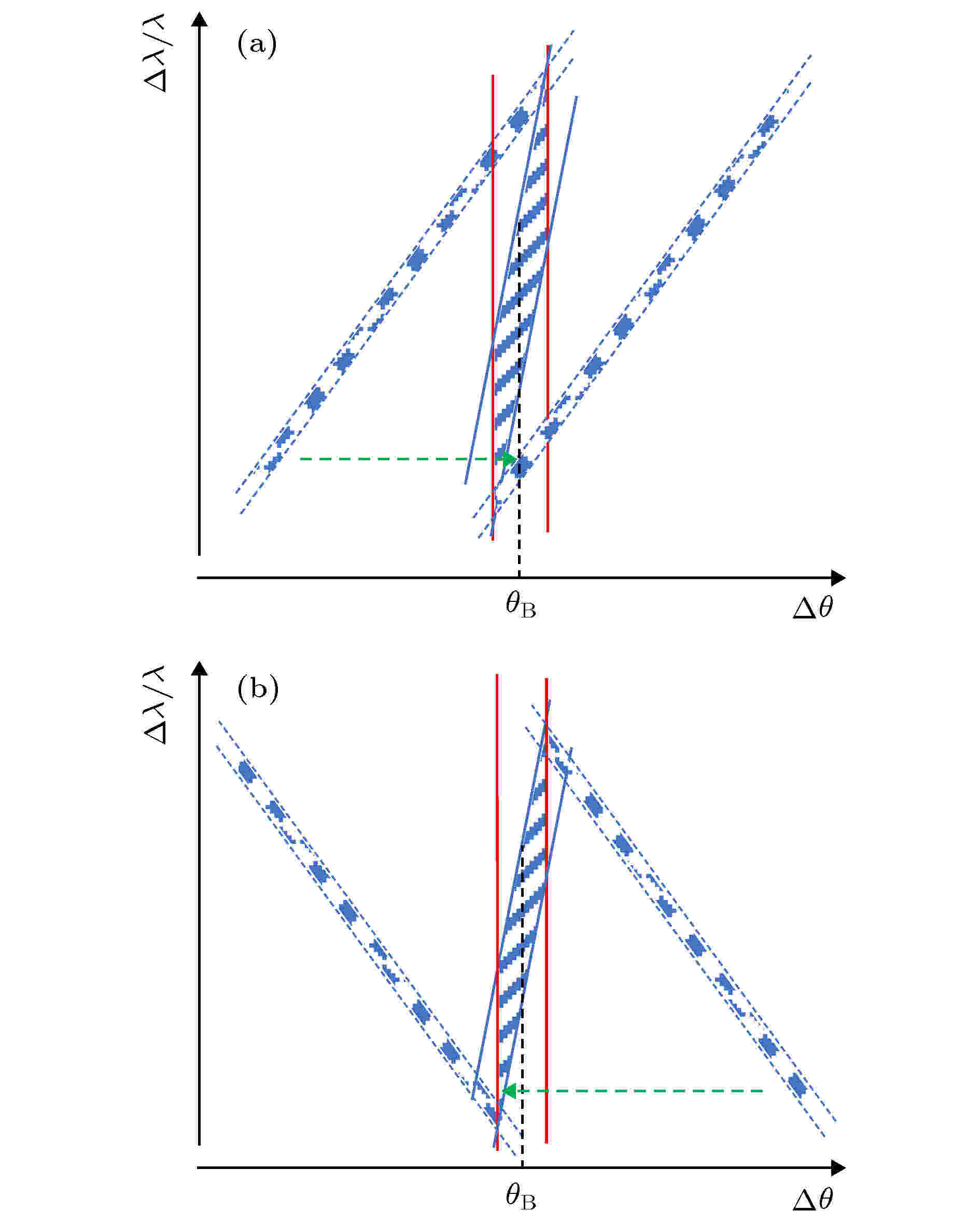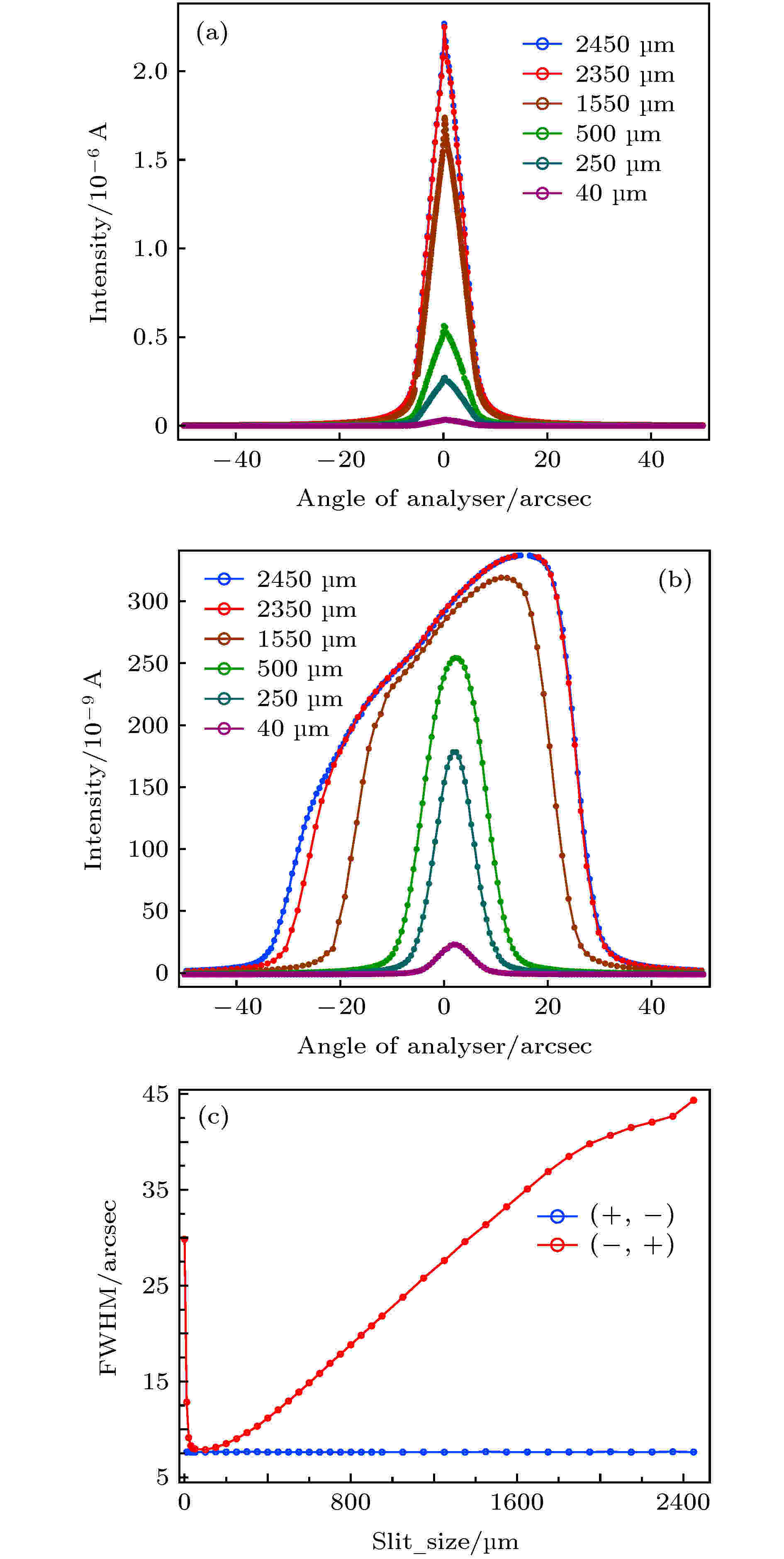全文HTML
--> --> -->同步辐射用户所看到的光束能量带宽/角发散等特性并不是一个一成不变的量, 它们会受到束线光源的尺寸/发散度、以及传输过程中的光学元件(狭缝、镜子等)参数和单色器分光特性等多种因素的复合影响. 由于一般出射光的能量带宽无法通过简单的测量直接获取, 因此针对同步辐射不同的工作能区、不同类型的单色器, 发展了多种表征束线、单色器能量带宽的方法[7-13]. 从一般测量的原理上论, 使用更高性能的分析器来表征束线/单色器的能量带宽是最简单明了的方法. 如在软X光束线站上, 可使用Ar、N原子中固有的能级结构作为分析器, 利用其吸收谱线来表征线站单色器的分辨率[14-16]. 但是, 在硬X光束线站上, 由于没有合适的元素吸收边可利用(带宽不够窄), 以及使用了双晶单色器(double crystal monochromator, DCM)结构的单色器, 便形成了采用第一晶(或第二晶)的摇摆曲线来表征单色器能量带宽的习惯. 随着越来越多光束线的建设, 类似束线表征的报道也越来越多, 角度与带宽的耦合模糊了单色器的本征带宽和用户所使用的束线带宽的区别, 以至于有些直接将单色器第一晶(或第二晶)的摇摆曲线半高宽换算成束线能量带宽的做法[5-6].
早在20世纪30代, DuMond提出了设计/分析单色器能量窗口的作图方法[17], 可以比较清晰地表达多晶体配置时的X线衍射的发散(接收)角度与能量带宽的函数关系. 后人称此为DuMond作图法, 是设计和解析单色器分光特性的有效工具. 因此, 测得束线单色器的DuMond图不仅能够明确得到被测束线的能量带宽和角度发散, 同时也是对同步辐射束线回归本真的表征法. 本文通过使用Si111/333分析晶体与束线的Si111双晶单色器构成的多晶体实验配置, 直接测量出该单色器的DuMond图, 测得了上海光源[18] BL09B X光学测试线上单色器的本征带宽和不同白光狭缝时束线的能量带宽.









2
2.1.单色器的DuMond图解
DuMond作图是Bragg衍射公式的图形表现形式, 其横轴是入射晶体光束的角度, 纵轴是满足衍射公式的光束的波长分布. 运动学意义上的DuMond图是一条横轴为










图1为一块完美晶体对称反射时的DuMond作图. 横轴是入射光的角度分布, 纵轴是衍射光的相对波长分布. 当入射晶体的光束有一定的发散角和频谱分布时, 衍射光束的波长和角度也出现相应的展宽. 图1中的作图可表述为: 衍射方程在图中是与纵轴成衍射角








 图 1 完美晶体对称反射的DuMond图. 微分衍射(2)式在图中对应的是一条斜率为
图 1 完美晶体对称反射的DuMond图. 微分衍射(2)式在图中对应的是一条斜率为
















Figure1. DuMond diagram for the symmetric Bragg geometry. The differential equation (2) of diffraction formula corresponds to the line band with a slope of














2
2.2.多晶体实验配置的X射线衍射及其特性分析
两块对称型晶体按照排列方式和衍射指数面的不同可组成4种配置方式实现对X射线的衍射, 分别为: (+n, –n)型、(+n, +n)型、(+n, –m)型和(+n, +m)型. 其中(n, n)表示使用同一指数面的晶体组合, (n, m)表示使用不同指数面的晶体组合; (+, –)表示两块晶体的衍射面法线位于第一晶出射光线(等同于第二晶入射光线)的两侧, (+, +)则表示两块晶体的衍射面法线位于第一晶出射光线的同侧. 图2和图3的双晶单色器的第二晶体和分析晶体分别构成(+, –)和(+, +)配置. 对于相同晶体的(+n, –n)型配置, 由于两块晶体在几何学中呈平行状态, 因此又称为是平行配置; 同时也因为通过第一晶体的光线同样可以通过第二晶体, 平行配置也称作无色散配置. (+n, –n)型配置是束线双晶单色器所采用的配置方式. 图4为分析晶体扫描单色器出射光过程的DuMond 图. 图 2 Si111双晶单色器的第二晶和Si111分析晶体构成(+1, –1)型无色散配置的实验配置图. [111]是衍射面法线的晶向
图 2 Si111双晶单色器的第二晶和Si111分析晶体构成(+1, –1)型无色散配置的实验配置图. [111]是衍射面法线的晶向Figure2. The experimental configuration of (+1, –1) type non-dispersive consists of the second crystal of Si111-DCM and Si111 analyzer. The[111] is the crystal direction of the normal of the diffraction plane.
 图 3 Si111双晶单色器的第二晶和Si111分析晶体构成(+1, +1)型色散配置的实验配置图
图 3 Si111双晶单色器的第二晶和Si111分析晶体构成(+1, +1)型色散配置的实验配置图Figure3. The experimental configuration of (+1, +1) type dispersive consists of the second crystal of Si111-DCM and Si111 analyzer.
 图 4 (a)和(b)分别为无色散(+1, –1)配置和色散(+1, +1)配置条件下, 分析晶体扫描单色器出射光过程的DuMond图. 斜线区域是双晶单色器的DuMond窗口, 圆点的区域是分析晶体的DuMond窗口
图 4 (a)和(b)分别为无色散(+1, –1)配置和色散(+1, +1)配置条件下, 分析晶体扫描单色器出射光过程的DuMond图. 斜线区域是双晶单色器的DuMond窗口, 圆点的区域是分析晶体的DuMond窗口Figure4. DuMond diagrams during scanning the output beam of DCM by analyzer. Panel (a) represents the non-dispersive (+1, –1) configuration and panel (b) represents the dispersive (+1, +1) configuration. The oblique line region is the DuMond window of the DCM. The point region is the DuMond window of the analyzer.
将上述结论用于装备了Si111双晶单色器的上海光源BL09光学测试束线和分析晶体, 则双晶单色器的第二晶和分析晶体可分别构成(+1, –1)型、(+1, +1)型、(+1, –3)型和(+1, +3)型的配置, 对应着图2、3、5和6. 在图2和图3中的分析晶体是Si111, 图5和6中的分析晶体是Si333. 图4(a)、(b)和图7(a)、(b)分别对应着图2、3和图5、6中实验配置时单色器的第二晶与分析晶体构成的DuMond图解. 在这里双晶单色器调整好之后便固定不动, 分析器晶体绕垂直于纸面的轴转动.
 图 5 Si111双晶单色器的第二晶和Si333分析晶体构成(+1, –3)型色散配置的实验配置图
图 5 Si111双晶单色器的第二晶和Si333分析晶体构成(+1, –3)型色散配置的实验配置图Figure5. The experimental configuration of (+1, –3) type dispersive consists of the second crystal of Si111-DCM and Si333 analyzer.
 图 6 Si111双晶单色器的第二晶和Si333分析晶体构成(+1, +3)型色散配置的实验配置图
图 6 Si111双晶单色器的第二晶和Si333分析晶体构成(+1, +3)型色散配置的实验配置图Figure6. The experimental configuration of (+1, +3) type dispersive consists of the second crystal of Si111-DCM and Si333 analyzer.
 图 7 (a)和(b)分别为使用Si333做分析晶体的(+1, –3)型和(+1, +3)型色散配置, 扫描单色器出射光过程的DuMond图. 绿色虚线箭头指示了扫描过程, 两个圆点的区域给出了分析晶体DuMond窗口起止位置
图 7 (a)和(b)分别为使用Si333做分析晶体的(+1, –3)型和(+1, +3)型色散配置, 扫描单色器出射光过程的DuMond图. 绿色虚线箭头指示了扫描过程, 两个圆点的区域给出了分析晶体DuMond窗口起止位置Figure7. DuMond diagrams during scanning the output beam of DCM by Si(333) analyzer. Panel (a) and (b) represent the (+1, –3) typeand (+1, +3) type dispersive configuration, respectively. The green dotted arrow indicates the scanning process. The two point-regions give the starting and ending position of the DuMond window of the analyzer.
对于图2所示的(+1, –1)型实验配置, 图4(a)中, 分析晶体入射光的DuMond窗口(点点区域)沿X轴的移动对应着实验中的晶体转动, Si111双晶单色器出射光的DuMond窗口是固定不动的斜线区域. 在DuMond图中, 当两个窗口有重合区域时, 在分析晶体出射光路上有光强信号出现. 这个配置在发生衍射时分析晶体输出强度的角分布只与两个窗口的角度宽度有关, 测得的摇摆曲线宽度等于双晶单色器的出射光角分布和分析晶体达尔文宽度的卷积, 不受光路上其它角度调控器件的影响. 而对于图3所示的(+1, +1)型实验配置, 由于分析晶体和双晶单色器的第二晶对称放置, 所以在图4(b)中, 分析晶体的DuMond窗口与Si111双晶单色器的DuMond窗口成镜像对称. 当分析器的窗口进入单色器的窗口时, 重合区域并不像无色散配置那样覆盖整个能量分布范围, 而是需要扫描一定的角度区域后才能覆盖整个能量带宽范围. 这使得出射光的强度变得较低(正比于窗口重合面积), 角度分布变得更宽. 由于单色器窗口中的不同波长出现在分析器不同的角度位置处, 因此这种晶体配置方式被称为色散配置. 在不考虑晶体本征达尔文宽影响时, 这个角度区域等于2倍入射到分析晶体光束发散角




将分析晶体改为使用333指数重复类似图2、图3的实验配置便是(+1, –3)型和(+1, +3)型配置(图5、图6). 图7(a)和(b)分别给出了它们扫描过程的DuMond图. 图7(a)与图4(a)的区别在于所使用分析晶体的衍射面指数与上游双晶单色器的衍射面指数不一致, 即便是(+, –)型的实验配置, DuMond图中的分析晶体窗口也与双晶单色器的不平行. 在转动分析晶体时也会产生色散现象. 因此(+n, –m)型和(+n, +m)型配置都属于色散型配置. 图7(a)和(b)与图4(b)的区别在于分析晶体DuMond窗口的斜率不同, 体现在扫描结果上即是色散程度不同. 因此这两种配置都是色散型配置. 其色散程度不仅与光束的发散角

由图4和图7的分析可知, 无色散实验配置中的分析器对颜色(波长)分布不敏感, 其出射光的摇摆曲线仅与双晶单色器和分析晶体本身的达尔文宽相关. 而色散型实验配置中的分析器则对颜色分布敏感, 其出射光摇摆曲线的宽度不但受入射光束角发散的影响, 也受单色器出射光的波长分布和分析晶体衍射面指数的影响. 因此, 一般单色器接收角度(达尔文宽)可通过对(+n, –n)配置下测得的摇摆曲线退卷积得到, 单色器的能量带宽则可以由(3)式间接推测.
要得到入射双晶单色器光束的角发散度




















由于色散配置下分析晶体摇摆曲线与光束的角发散和带宽都有关联, 通过系列地调节束线上的狭缝改变光束的发散角和测量在该发散角时的分析晶体摇摆曲线, 可以分离出来通过单色器后出射光束的角分布, 进而可以获得束线单色器的DuMond图. 获得了束线单色器的DuMond图之后, 便可以直接读出单色器的本征能量带宽、在不同狭缝宽度时的束线能量带宽、以及光源的角发散等光束线的基本信息.
按照图2搭建无色散配置的实验光路, 通过使用Cu元素的吸收边校正双晶单色器的工作能量, 使其出射光能量为10 keV. 分别调整双晶单色器和分析晶体满足能量为10 keV的衍射条件以及用PIN探测器测量转动分析器角度时的衍射强度. 其具体过程为: 1)转动Si111分析晶体, 并记录这个条件下的摇摆曲线. 2)以100 μm的步长逐步减小狭缝纵向宽度, 然后重复1)的测量过程. 这样的操作可获得一系列不同狭缝宽度的分析晶体摇摆曲线. 当狭缝纵向宽度减小到950 μm时, 改变步幅为50 μm; 当狭缝纵向宽度减小到50 μm时, 改变步幅为10 μm, 直至光强为零, 不能测量到信号强度为止. 选择不等间隔的调整步幅既可以保证得到在同步辐射中心附近比较精细的角分布信息, 又可以减少整个系列测量的总次数, 节省实验时间. 在完成(+1, –1)的实验配置后, 将实验配置依次改为(+1, +1)、(+1, –3)和(+1, +3)的色散配置, 重复上述的调整狭缝的数据采集过程, 然后获得在色散配置下一系列不同狭缝宽度下摇摆曲线.
 图 8 (a)和(b)分别为无色散配置和“固定”色散配置条件下不同狭缝纵向宽度时Si111分析器的摇摆曲线. (c)是无色散配置和“固定”色散配置条件下随狭缝宽度调节时摇摆曲线的半高宽的曲线
图 8 (a)和(b)分别为无色散配置和“固定”色散配置条件下不同狭缝纵向宽度时Si111分析器的摇摆曲线. (c)是无色散配置和“固定”色散配置条件下随狭缝宽度调节时摇摆曲线的半高宽的曲线Figure8. (a) and (b) give the rocking curves of the Si (111) analyzer with different slit vertical widths under the conditions of non-dispersion configuration and “fixed dispersion” configuration, respectively. (c) gives the FWHM curve of the rocking curve when the slit vertical width is adjusted under the condition of non-dispersion configuration and “fixed dispersion” configuration.
值得注意的是, 色散配置下的摇摆曲线半高宽数据(图8(c))靠右侧的半高宽值虽然随狭缝纵向宽幅的增加而变大, 但增加的速度变缓. 这是因为狭缝宽幅决定的接收角已接近光源的纵向发散角, 狭缝的角度调制作用接近失效; 而最左侧变大现象是因为在狭缝很小时, 出现狭缝的X射线衍射和小狭缝时摇摆曲线的信噪比变差, 导致了分析器的摇摆曲线半高宽变大. 在狭缝宽度较小时, 色散配置的半高宽变化变缓且趋于水平不变, 其原因是因为狭缝宽度所决定的光束接收角与单色器中晶体衍射的达尔文宽接近, 狭缝继续减小后分析晶体的达尔文宽起支配作用.
图9(a)和(b)分别给出了使用Si111分析晶体在无色散和“固定”色散配置时, 系列狭缝宽度调制条件下摇摆曲线做差分后的结果. 图中的纵轴是不同宽度的狭缝做逐差后的位置(注: 狭缝宽度等于0处与光轴中心略有差异, 但不影响结果的讨论, 为方便叙述下文把狭缝宽度等于0处描述为光轴中心), 横轴是分析器的角度位置. 对狭缝宽度做逐差的意义在于可以把图1所示束线的DuMond图从不同狭缝位置(角度)处提取出来, 即把角度从与波长的耦合关系中剥离出来. 图9(a)显示了无色散晶体配置方式的测量结果与狭缝位置无关, 这是因为无色散配置方式不能解开波长与角度的耦合关系, 摇摆曲线的峰位只出现在分析晶体的DuMond窗口与双晶单色器的DuMond窗口完全重合处. 结合图8(c)中无色散配置的摇摆曲线的半高宽不随狭缝宽度变化的结果, 我们可以得出如下结论: 无色散的实验配置因为不涉及能散的问题, 只适用于评价双晶单色器中第一晶体的应力变形, 不适合用来评价出射光的带宽. 与此相对照的是色散型的实验配置. 由于在该配置中, 衍射可以把光线中波长分布转换成角度分布, 表现在图9(b)中即是差分的结果会随狭缝逐差位置的变化而改变, 因而这种实验配置方式下可以把角度解调出来, 从而得到束线单色器的DuMond图. 不同的狭缝逐差位置意味着不同的入射晶体角度, 依据Bragg公式, 角度的分布可以转换为波长的分布. 将图9(a)和(b)纵轴的狭缝逐差位置转换为波长分布即是束线单色器的DuMond图. 但在这里为了清晰显示分析晶体差分和狭缝逐差的过程. 同时从图9(b)上已经可以获得不同狭缝宽度条件下的摇摆曲线半高宽, 应用(4)式和(5)式便可以得到束线的能量带宽. 故不再对图9做进一步处理.
 图 9 (a)和(b)分别为使用Si111做分析器时, (+1, –1)和(+1, +1)实验配置条件下摇摆曲线做差分后的结果. 横轴的坐标原点对应着10 keV时分析晶体的衍射角. (b)同时还是在“固定”色散排列条件下使用Si111做分析器得到的未经狭缝(角度)——波长转换的“赝”DuMond图. 从图中可以直接读取不同狭缝宽度下得到的摇摆曲线半高宽的测量值
图 9 (a)和(b)分别为使用Si111做分析器时, (+1, –1)和(+1, +1)实验配置条件下摇摆曲线做差分后的结果. 横轴的坐标原点对应着10 keV时分析晶体的衍射角. (b)同时还是在“固定”色散排列条件下使用Si111做分析器得到的未经狭缝(角度)——波长转换的“赝”DuMond图. 从图中可以直接读取不同狭缝宽度下得到的摇摆曲线半高宽的测量值Figure9. (a) and (b) show the results of slit width difference of rocking curve with (+1, –1) and (+1, +1) experimental configurations with Si111 analyzer, respectively. The coordinate origin of the transverse axis corresponds to the diffraction angle of the analytic crystal at 10 keV. Also, (b) is the DuMond diagram without slit (angle) - wavelength conversion obtained using Si111 analyzer under the condition of dispersion configuration. The measured values of rocking curve FWHM with different slit widths can be read directly from the figure.
综上分析, 由图8(c)得出上海光源BL09B光学测试线的Si111双晶单色器在10 keV处的带宽为5.40(4)'', 其理论值为5.38'', 该展宽来自双晶单色器中第一晶的热变形效应. 由图9(b)“赝”DuMond图可以得出束线带宽的测量值为52(1)'', 利用(4)式和(5)式可以得出上海光源BL09B光学测试线的束线(狭缝全开)带宽为26(1)'', 其理论值为25.8''.
图10(a)和(b)分别给出了使用Si333做分析晶体的(+1, –3)型和(+1, +3)型实验配置时测得的“赝”DuMond图. 由图10(a)和(b)可以得出, 不同实验配置下分析晶体测得的束线带宽的测量值分别为67(1)''和117(1)''. 在退分析器卷积和消除色散展宽后, 得到束线的带宽为26(1)'', 与使用Si111做分析晶体得到的结果相吻合.
 图 10 (a)和(b)分别为使用Si333做分析器时, 在(+1, –3)型和(+1, +3)型实验配置条件下得到的“赝” DuMond图
图 10 (a)和(b)分别为使用Si333做分析器时, 在(+1, –3)型和(+1, +3)型实验配置条件下得到的“赝” DuMond图Figure10. (a) and (b) give the pseudo DuMond diagram using Si333 analyzer under the condition of (+1, –3) type and (+1, +3) type dispersion configuration, respectively.
上述各种测量结果以及理论计算值一并列在表1中. 将上述测得的角宽度值代入式(2), 可以得出上海光源BL09光学测试线Si111双晶单色器在10 keV的相对能量带宽为1.30(1) × 10–4. 考虑到束线的角度发散影响后, 在狭缝全开的情况下, 得到束线在10 keV单色光时的相对能量带宽为6.3(2) × 10–4.
| 分析器衍射面 | 实验配置 | 色散类别 | 测量值 | 退卷积和色散展宽值 | 理论值 | 备注 |
| (111) | (+n, –n) | 无色散 | 7.64(4) | 5.40(4) | 5.38 | 双晶单色器带宽 |
| (+n, +n) | “固定”色散 | 52(1) | 26(1) | |||
| (333) | (+n, –m) | “弱”色散 | 67(1) | 26(1) | 25.8 | 光束的带宽 |
| (+n, +m) | “强”色散 | 117(1) | 26(1) |
表1不同实验配置得到的实验值以及退分析器卷积和色散展宽后的值. 单位: 角秒(″)
Table1.The experimental values obtained from different experimental configurations and the values after deconvolution of the analyzer and removal of dispersion broadening. Unit: arcsec.
综上所述, 同步辐射束线的诊断需要借助于使用分析器以及一系列的诊断测量. 通过使用与双晶单色器呈无色散配置的分析器晶体, 可以测得束线单色器的带宽; 而使用色散配置的晶体分析器可以解析出束线的带宽. 在色散实验配置下, 通过对一系列入射狭缝宽度调制时的摇摆曲线进行差分, 可以获得束线的DuMond图. 此外, 虽然使用(+n, –m)型和(+n, +m)型色散实验配置也可以得到束线的能量带宽, 但是在这种条件下, 展宽因子的解析比较复杂. 故在实验条件允许的情况下, 使用与双晶单色器同衍射指数的分析晶体是方便合理的选择. 此外, 对束线角度带宽退双晶单色器角度带宽的卷积, 可以得到光源的角发散度. 由上述结果得到的上海光源BL09B光学测试线的光源角发散度为25(1)''.
通过使用Si333做分析晶体的方法验证了使用色散配置的分析晶体可以获得束线DuMond图的普适性, 同时也给出了经单色器后束线的带宽. 此外, 使用由(+1, +1)、(+1, –3)和(+1, +3)型配置得到的束线带宽退除由(+1, –1)型配置得到的双晶单色器带宽的卷积得到了光源的发散角为25(1)''.
